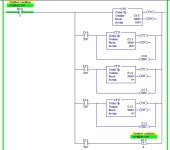I have an application where I need to keep a running stroke count that goes higher than 16,777,220. I am currently adding 1 to a float in a SLC 5/04 every time the machine cycles and am displaying it on a Panelview. I've now reached 1.677722e+7 and would like to count higher and still be able to display an accurate number on the PV. Any ideas on how to do this?
Thanks
Kyle
Thanks
Kyle







